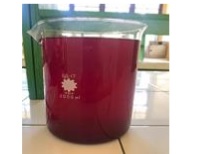Study Effect of Chitosan-Epichlorohydrin Macropore Beads on Decreasing the Value of Total Dissolved Solid (TDS) and Dyes in Sasirangan Liquid Waste Treatment
Abstract
Sasirangan liquid waste contains contaminants that are quite dangerous, characterized by high values of total dissolved solids and dyestuffs. This study aims to determine the effect of dose and pH on chitosan-epichlorohydrin macropore beads. The parameters of the measured waste are total dissolved solids and dyestuffs. The process of absorption of sasirangan liquid waste characterizes by FTIR. The results showed that chitosan-epichlorohydrin beads that interacted with sasirangan liquid waste had optimum results at a chitosan dose of 600 mL/L, with a decrease in the total value of dissolved solid by 2161 mg/L and a decrease in dye by 84.78%. Chitosan-epichlorohydrin beads at pH against total dissolved solid gave optimum results at pH 7 with a reduction in the total dissolved solid value of 2269 mg/L, while pH against dyestuffs gave optimum results at pH 3 with a decrease of 94.09%. The interaction between chitosan and chitosan-epichlorohydrin beads occurred a shift in wave numbers from 943 cm-1 to 932 cm-1 showing the C-O-C group and the chitosan-epichlorohydrin beads spectra with waste at wave numbers 3013-3618 cm-1 to 3007-3631 cm-1 the O-H vibration group overlapped the N-H vibration and showed the result that the beads Chitosan-epichlorohydrin/adsorb sasirangan liquid waste.
Downloads

Copyright (c) 2023 Dahlena Ariyani, Nabila Khairiyatul Hilma, Umi Baroroh Lili Utami, Uripto Trisno Santoso, Dwi Rasy Mujiyanti

This work is licensed under a Creative Commons Attribution-NonCommercial-NoDerivatives 4.0 International License.
Authors who publish with this journal agree to the following terms:
- Copyright on any article is retained by the author(s).
- The author grants the journal, the right of first publication with the work simultaneously licensed under a Creative Commons Attribution License that allows others to share the work with an acknowledgment of the work’s authorship and initial publication in this journal.
- Authors are able to enter into separate, additional contractual arrangements for the non-exclusive distribution of the journal’s published version of the work (e.g., post it to an institutional repository or publish it in a book), with an acknowledgment of its initial publication in this journal.
- Authors are permitted and encouraged to post their work online (e.g., in institutional repositories or on their website) prior to and during the submission process, as it can lead to productive exchanges, as well as earlier and greater citation of published work.
- The article and any associated published material is distributed under the Creative Commons Attribution-NonCommercial-NoDerivatives 4.0 International License.





_copy1.png)










